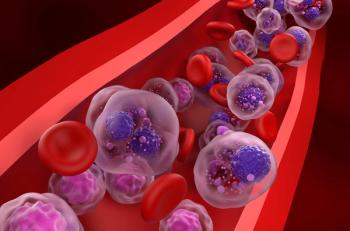
Defining Indolent Relapse Multiple Myeloma
Dr Haumschild opens the discussion with Larry Anderson, MD, PhD, and Gabe Hinojosa, PharmD, BCOP, regarding various states of relapse in multiple myeloma.
Episodes in this series
Ryan Haumschild, PharmD, MS, MBA: Hello, and welcome to this Pharmacy Times® Practice Pearls program titled “Differentiating Management for Patients With Indolent Relapse Compared to Aggressive Relapse Multiple Myeloma.” My name is Ryan Haumschild, the director of pharmacy services at Emory Healthcare at the Winship Cancer Institute in Atlanta, Georgia. Joining me in this discussion are Dr Larry Anderson, a professor in the department of internal medicine at UT [University of Texas] Southwestern Medical Center [in Dallas, Texas] and the division of hematology-oncology, and Dr Gabe Hinojosa, a clinical pharmacy specialist in hematology-oncology, bone marrow transplant, and cellular therapy at UT Southwestern Medical Center. We’re going to talk about several topics pertaining to relapse multiple myeloma, including discussions on indolent relapses, the evolving treatment landscape for indolent relapse, and the role of pharmacists in multiple myeloma. Let’s get started.
As we get started talking about indolent disease and multiple myeloma, it’s important to give an overview of the disease burden. Dr Anderson, could you define indolent relapse multiple myeloma compared with relapsed/refractory multiple myeloma? Describe the differences in presentations and some of the clinical symptoms. How often are these patients evaluated for relapse compared with other patients within the relapsed/refractory setting?
Larry Anderson, MD, PhD, FACP: Great question. The difference between an indolent myeloma relapse and aggressive or refractory relapse are that the indolent relapses are going to be what we call a biochemical relapse, in which markers in their blood gradually rise over time—not rapidly doubling but barely meeting criteria for relapse or progression, not developing new bone lesions and fractures and anemia. We have more time to treat it and to get it under control. But refractory or aggressive relapse would be patients who have their markers rise but also have clinical symptoms and need urgent treatment.
Ryan Haumschild, PharmD, MS, MBA: When you’re evaluating these patients, is there a sequence or a cadence for relapse that might be different from other patients?
Larry Anderson, MD, PhD, FACP: We typically follow these patients with myeloma every 1 to 3 months, depending on what treatment they’re on for maintenance. We find that these markers precede clinical symptoms in many cases. If they’re starting to rise and they’re on a 3-month schedule, for example, we’ll move to monthly or something like that to watch them more closely. But if they’re developing new symptoms and bone lesions, we’ll have to do their work-up promptly and get their treatment switched within a week or 2.
Ryan Haumschild, PharmD, MS, MBA: I know you’re familiar with this, but when patients relapse, what are some of the tools, labs, and measurements that you’re utilizing to define a patient as relapsed or someone you want to watch more closely in indolent disease?
Larry Anderson, MD, PhD, FACP: By definition, relapse—based on the International Myeloma Working Group criteria—would be a rise of their monoclonal protein spike by 0.5 g/dL above their low point or a rise of their serum-free light chains by 100 points above their low point. Sometimes these indolent patients may take months or even years to gradually rise like that. On the other hand, patients with more aggressive disease may be rapidly doubling within a week or 2. But the main markers we’re following are the monoclonal protein spike on electrophoresis and the serum-free light chains. For patients who have a history of more aggressive disease, we’ll often combine that with some periodic imaging to watch for early changes in their bone lesions or growth of bone lesions or new fractures and things like that before they develop symptoms.
Ryan Haumschild, PharmD, MS, MBA: That’s a great overview, especially because we’re evaluating what symptomology looks like for some patients. With indolent [disease], is it different? How are we monitoring that? There might be some common patient factors. Mr Hinojosa, I have some questions. When we start to look at indolent relapse patients with multiple myeloma, are there any criteria or patient-specific factors that stand out, such as age, lifestyle, or even the fitness of the patient?
Gabe Hinojosa, PharmD, BCOP: Not so much patient-specific factors with regard to age, lifestyle, and activity, but certainly within their disease status and cytogenetics at the time of initial diagnosis. Patients who have a standard-risk disease or cytogenetics are more likely to move on to that indolent type of relapse. But for high-risk cytogenetics, like translocation 14;16 or TP53 mutations, those are the patients in whom we’d expect to see more relapsed/refractory myeloma.
Ryan Haumschild, PharmD, MS, MBA: Excellent. I appreciate that background. As we start to think about diagnosis, we talked a little about the types of patients and some of the factors we look for. Dr Anderson, go into a little more detail. How is indolent relapsed multiple myeloma diagnosed? You talked about the criteria, but maybe give us a little more detail. Talk a little about early intervention. How does that impact the overall outcomes for these patients on their care continuum?
Larry Anderson, MD, PhD, FACP: The place where we can make 1 of the biggest benefits is intervening in patients with the indolent relapses because we can potentially catch them while we’re following their serum markers show relapse without clinical symptoms. If we intervene, in time we can prevent them from developing anemia, bone lesions, and pain and some of the comorbidities from myeloma that lead to poor quality of life.
Ryan Haumschild, PharmD, MS, MBA: Is there a risk-benefit [analysis] when you’re concerned? Do we start early treatment? We want patients with plasma cell disorders to live a long time. There are multiple therapies, but how do we keep that overall response rate high? How do you do that risk-stratification assessment for patients? Do you say, “Early intervention is important, and we’re going to preserve quality of life and reduce bone pain”? Or do you say, “We may want to hold off treatment for this patient”? Talk me through that.
Larry Anderson, MD, PhD, FACP: It depends on the patient and a lot of patient-specific factors, like if the patient has a history. When they were first diagnosed, did they have kidney failure from light chain elevation? We’re going to want to intervene in patients with any mild rise of their light chains rather than wait until they’re skyrocketing. If they had presented with severe bone disease, we’re probably going to intervene even with early biochemical or indolent relapse rather than wait until they develop significant symptoms. The rapidity of the rise of the markers helps determine how aggressive we want to be. If it’s gradually rising over many months or years, then sometimes we can do minimal things to delay full-blown progression. We could even add weekly dexamethasone or another oral agent before making them commit to coming in and doing intravenous or subcutaneous injections. But if we know that patient had bad symptoms at diagnosis and is progressing, we’re probably going to be more aggressive and have them come in and do things that are more likely to get them under control faster.
Ryan Haumschild, PharmD, MS, MBA: That makes a lot of sense. With multiple myeloma, there are many patient considerations.
Transcript edited for clarity.
Newsletter
Stay informed on drug updates, treatment guidelines, and pharmacy practice trends—subscribe to Pharmacy Times for weekly clinical insights.





































































































































































































